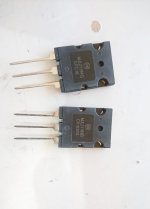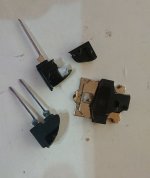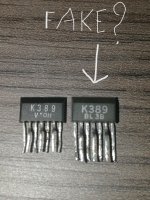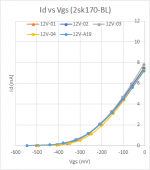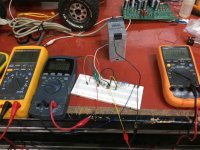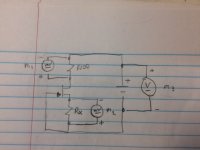Could anyone identifiy these as genuine or counterfeit devices please? I've bought them many years ago in some sort of a kit and had them laying in my drawer since then. The stamp under the part number doesn't match the description in the datasheet, so it may be safe to throw them away?
Attachments
Last edited:
Check this link, if you can spare one, crack it open in a vice, the die will tell you.
https://www.google.com/url?sa=t&sou...FjACegQIAhAB&usg=AOvVaw0KHY8KwNp8-LMdQUQlc4bU
https://www.google.com/url?sa=t&sou...FjACegQIAhAB&usg=AOvVaw0KHY8KwNp8-LMdQUQlc4bU
That’s an attempt at reproducing the Fairchild version of the package, which was not in use by ON for its original MJL’s in 2010 (the 3 little notches at the bottom to increase the voltage rating of the package for switchmode and horizontal output use). And it has the G suffix, but the non-G lead finish.
Old ones prior to the Fairchild merger would have the old flat-across-the-bottom package. They continued to use the old one for a while, but gradually switched everything to the Fairchild version. But those would ALL be the G suffix, and the matte finish on the leads and backside. If you see a G and shiny Pb-solder-tinned leads walk away very quickly.
Old ones prior to the Fairchild merger would have the old flat-across-the-bottom package. They continued to use the old one for a while, but gradually switched everything to the Fairchild version. But those would ALL be the G suffix, and the matte finish on the leads and backside. If you see a G and shiny Pb-solder-tinned leads walk away very quickly.
No silicone with most originals. There was a time when some originals had silicone, but not Motorola. And never with plastic packages. I’ve seen original Toshiba TO-3’s from the 70’s and 80’s that had silicone. These were original parts which got replaced, due to shorted speaker wires or too many speakers in parallel. After years of use. Not much chance of being fakes.
Even good copy cats have silicone. I cut open a spare MOSPEC 2N6609 a few months ago. I’ve always had good luck with them in general - even since the 90’s. They have a full size die, a proper heat spreader coin, but they do have silicone. And I did have to saw the top hat off - it didn’t just pop loose like fake ON’s would.
But again, I a he never seen it with plastic packages. Why? Because of the mechanical stresses between the molding compound and the silicone. it can cause bond wires to come off. Not an issue in an air cavity hermetic package.
Even good copy cats have silicone. I cut open a spare MOSPEC 2N6609 a few months ago. I’ve always had good luck with them in general - even since the 90’s. They have a full size die, a proper heat spreader coin, but they do have silicone. And I did have to saw the top hat off - it didn’t just pop loose like fake ON’s would.
But again, I a he never seen it with plastic packages. Why? Because of the mechanical stresses between the molding compound and the silicone. it can cause bond wires to come off. Not an issue in an air cavity hermetic package.
LittleDiode are getting some really awful reviews here. It appears that they are buying from anywhere without checking if the parts are genuine.
Beautifull.....and so I burn my power amp!!!
Someone know jfet copy austetics.... Original pin are smaller.... Writing on original are more spaced...
Littlediode may be a UK seller but his product is mainly Chinese !!
OK.... Who know european online store that sell genuine parts?
You'll be really hard pressed to get new 2SK389, you might get pulled ones.
Check out the Pass forum, you'll probably be able to get matched JFETs that would replace it.
I don't understand.... You mean a private forum member that sell me one?
I found some 2sk170's I purchased in the early 2000's, but thought I should check to see if they were early fakes.
I made a jig similar to the EUVL 3-point matching jig, but used R100 for his R2 and chose different values of R1 to get Vgs in roughly 50mV increments (sketch of schematic and pic of circuit attached). I used 3 DMM's to measure Vds (to make sure it didn't drift), Vgs and V across R100 to get Id.
Following is the chart of my measurements. To me it looks very similar to the graph in the 2sk170 datasheet.
Is this enough data to prove that these are not fake devices? Without special tools, is there a better way to verify this?
Thanks for any input.
Sandy.
I made a jig similar to the EUVL 3-point matching jig, but used R100 for his R2 and chose different values of R1 to get Vgs in roughly 50mV increments (sketch of schematic and pic of circuit attached). I used 3 DMM's to measure Vds (to make sure it didn't drift), Vgs and V across R100 to get Id.
Following is the chart of my measurements. To me it looks very similar to the graph in the 2sk170 datasheet.
Is this enough data to prove that these are not fake devices? Without special tools, is there a better way to verify this?
Thanks for any input.
Sandy.
Attachments
- Home
- Design & Build
- Parts
- My Transistors, original or copy?
